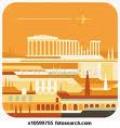
WRITING ABOUT A GREEK TOWN / CITY / AREA
by our 4th grade students
The students of the 4th grade of our school have found information on and written about a Greek town, or city of their choice for a school project in English. We are more than happy to host in this issue their assignments!
EDESSA
by Kostas B.
Edessa is near a river. In is in the Northern Greece. It is a large city. There you can see a lot of cherry and peach trees. People eat fish from the river. There is also a waterfall and the place is famous for it.
MY AREA
by Theofania B.
My area is Almyros. It is a beautiful area. There are big parks and supermarkets. Volos is near my area. Volos has got a big bridge and big streets. Almyros has got a shopping centre. In Almyros there aren’t any sports centers or cinemas. This is my beautiful area!
EPIRUS
by Jim V.
My favourite place in Greece is Epirus. It’s on the northern-western part of Greece. My favourite city is Ioannina. Other cities are Arta, Preveza and Egoumenitsa. There are many beautiful beaches, like Parga, and high mountains, such as Mitsikeli, Smolikas and Joumerka. There is a beautiful lake near Ioannina, lake Pamvotida. In this area, there are also many rivers, such as Acheloos, Arathos, Louros, Kalamos and Aherodas. Famous sights are the island of Mrs Frossini, the Museum, the castle of Ioannina, Paul Vrellis Greek History Wax Museum and the University of Ioannina.
CRETE
by Maria M.
Crete is a big island in south Greece. Chania, Rethymno and Lasithion are three beautiful places that you have to visit. You can go swimming there, too! The palace of Knossos and Samaria Gorge are very beautiful to visit!
MYTILENE
by Ioanna V.
It is an island in the eastern part of Greece, near Turkey. The most important towns are Plomari, Sikounda, Eressos and Petra. There aren’t any lakes or many rivers, but there are some mountains. You can see two castles, an archaeological site, a spa center and many monasteries. You can eat fresh fish and its famous Greek cheese. There is also a famous festival in August. Finally, there is a rare, but famous forest that you can see.
ANAVRA
by Konstantina H. and Vaggelitsa P.
Anavra is a village on a mountain. It is in Magnesia, in central Greece. You can visit the park of Anavra. There is also a beautiful forest and a cave. On the mountain, there are cows, goats and sheep. A sight you can see is a place near the park which is called ‘Anavra’. It is like a lake, where people wash their clothes and carpets. You can eat great meat and cheese there. Every year, in the summer, people celebrate in a festival. They eat, drink, sing and dance. They celebrate St. Panteleimonas.
THESSALY
by Mary and Anastasia A.
Name: Thessaly. Capital city: Larissa. Other important cities: Volos, Karditsa, Trikala. Sights: Meteora, Aspropotamos, National Sea Park of Alonnisos, Villages of Pilio, Lake of Plastira, Tembi valley. Mountains: Othrys, Pilio, Olympus, Koziakas. Lakes: Lake of Plastira.
Thessaly is in the center of Greece and it is an area full of mountains, but there are still some important valleys like Larisa, Farsala, Trikala and Almyros and some rivers like Pinios, Enipeas etc. In the winter, tourists can visit some ski centers and in the summer they can swim in its beautiful beaches. They can visit some traditional restaurants in the mountains and some small taverns at the beaches of Thessaly. Anyway, Thessaly sure is a good destination for everyone to visit.
LEMNOS ISLAND
by Christina P.
You must visit the castle of Myrina and the village Moudros. Myrina has got a big castle. It was the basis of the pirates in World War I. In Kaminia there is a temple and the ancient site of Poliohni.
IKARIA
by Katerina K.
Ikaria is a big, wonderful island. It is in Aegean Sea, close to the western part of Myconos. This island is special. People can visit many places there, like Amalo, Armenistis, Karkinagri, etc. There are many green forests and museums which people can visit in this beautiful, amazing island!
Eastern Thessalia
by Costas M.
The eastern part of Thessalia has two big cities: Larissa and Volos, and other important towns, like Almyros, Elassona and Tirnavos. The most important mountains are Olympus, Pilion, Ossa and Othris. It also has two rivers, Pinios and Enipeas, and a lake, called Karla. The most famous sights in Eastern Thessalia are Tempi, Zagora in Pilion, Olympus and N. Aghialos and you can visit the carnival in Tirnavos, too. In Eastern Thessalia there are also some rare animals in Alonissos, the Mediterranean monk seal ‘Monachus Monachus”.
PELOPONESSUS
by Anastasia and Mary A.
Peloponessus is the south part of landlocked Greece. It has seven districts (Argolida, Arkadia, Achaia, Elia, Corinthia, Laconia and Messenia). It has a shape that looks like a pergola leaf. That’s because it has many gulfs and many nazes. Peloponessus has a climate that is generally Mediterranean. In the winter, the climate is chillier and more freezing in the mountains than at its sea areas. It is rainier at its east part than it is at the west (it is less rainy in Pyrgos than in Nafplio).









